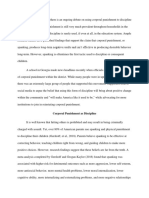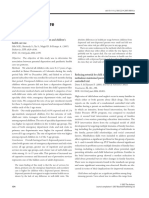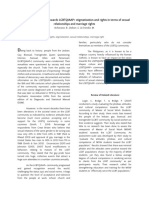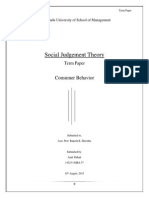Critical Analysis No. 1 Rewrite
Critical Analysis No. 1 Rewrite
Uploaded by
milquenieremacalipsay24Copyright:
Available Formats
Critical Analysis No. 1 Rewrite
Critical Analysis No. 1 Rewrite
Uploaded by
milquenieremacalipsay24Original Title
Copyright
Available Formats
Share this document
Did you find this document useful?
Is this content inappropriate?
Copyright:
Available Formats
Critical Analysis No. 1 Rewrite
Critical Analysis No. 1 Rewrite
Uploaded by
milquenieremacalipsay24Copyright:
Available Formats
Critical Analysis of "Corporal punishment and its effect in Children" by Rimal HS¹, Pokharel A²
Introduction
In the year 2013, Authors have researched and reviewed Globally and in the developing country
specifically Nepal, stating that “ Corporal punishment in children is still a major problem throughout the
globe and more common in developing countries like Nepal. Several researches done across the globe
have clearly established the fact that use of corporal punishment at home, school or alternative settings
is associated with higher prevalence of externalizing behaviour of youth, substance use, depression,
juvenile delinquency, poor academic performance and marital conflict as an adult.” ( Journal of
Kathmandu Medical College, Vol. 2, No. 3, Issue 5, Jul.-Sep., 2013)
Summary of work
This research stated that how will the corporal punishment work by stating that “Advocates of physical
punishment may have observed that it may lead to immediate compliance but this outcome tends to be
short lived, with the child learning to avoid the behavior in front of the adult, rather than actually
changing their behavior.” , “Globally, more and more countries are establishing legislation that provides
legal defense against assault of children by parents as part of discipline and many countries are
reviewing their legislation in this area. It is important to educate parents about the most effective forms
of discipline that will help to guide children’s behavior.” But still also inconsistent in the countries and
especially to the developing countries fir the reason that some are still lingering to the effects not now
but on the long run. Some may disagree in using corporal punishment to the extent that they will injure
a child not only physically but emotionally.
Argument
They have already discussed on what will be the effects of Corporal punishment and also the long term
effects. And inNepal, Corporal punishment remains a significant issue in many developing countries,
including Nepal, and it can have profound negative effects on children's well-being and development. Also In
Nepal, corporal punishment is still widely accepted and practiced in various settings, including schools,
homes, and institutions. This is often rooted in cultural beliefs, lack of awareness about child rights, and a lack
of effective positive disciplinary techniques.
Unfortunately, I don't have specific data or research on the prevalence and effects of corporal punishment
on children in Nepal. However, based on global research and studies on corporal punishment, we can infer
some potential effects it may have on Nepali children.
And also as statedCorporal punishment is still widely practiced in Nepal, both at home and in schools, despite
efforts by the government and child rights organizations to discourage and ban it. It's important to note that
these potential effects are based on global research and may not fully reflect the specific cultural and social
contexts of Nepal. More research and data on the prevalence and impact of corporal punishment in Nepal
would be helpful in understanding the extent of the issue and developing appropriate interventions and
support systems for children and families.
Conclusion
In Conclusion, I can state that Rimal HS and Pokharel A's research regarding on the corporal analysis and
it's effect on children is a really great piece of work. Because they stated on the research that Corporal
punishment is still a major problem not only it is exercised in Nepal but to some countries. The things
that fascinated me in this study not only they touched on how will be the probable causes of corporal
punishment and it's long term effects. Also they have stated the solutions on how to handle this
situations.
You might also like
- Sacks Sentence Completion TestDocument6 pagesSacks Sentence Completion Testsv6121096100% (1)
- "Smacking Never Hurt MeDocument9 pages"Smacking Never Hurt MeAdis AuraNo ratings yet
- Syllabus: Children With Sexual Behavior IssuesDocument10 pagesSyllabus: Children With Sexual Behavior IssuesJane GilgunNo ratings yet
- Negativism Effects of Physical Punishment of Children (Proposal)Document5 pagesNegativism Effects of Physical Punishment of Children (Proposal)Fatima AltuhaifaNo ratings yet
- Order#5274579Document8 pagesOrder#5274579Gaddafi PhelixNo ratings yet
- Eng 105 Research Paper On: "Growing Through Punishment"Document18 pagesEng 105 Research Paper On: "Growing Through Punishment"Easha ImtiazNo ratings yet
- Literature Review Edu 630Document25 pagesLiterature Review Edu 630Maria KhanNo ratings yet
- feeel fel iz 1112222Document33 pagesfeeel fel iz 1112222fel izNo ratings yet
- Corporal Punishment and Annotated BibliographyDocument10 pagesCorporal Punishment and Annotated Bibliographyluqqct outNo ratings yet
- Outcomes of Parental Discipline StylesDocument39 pagesOutcomes of Parental Discipline StylesLimdra NitaNo ratings yet
- Systematic Reviews of Interventions Following Physical Abuse: Helping Practitioners and Expert Witnesses Improve The Outcomes of Child Abuse, UK, 2009Document6 pagesSystematic Reviews of Interventions Following Physical Abuse: Helping Practitioners and Expert Witnesses Improve The Outcomes of Child Abuse, UK, 2009Beverly TranNo ratings yet
- Hassanali Article Review - Child Care ArrangementsDocument8 pagesHassanali Article Review - Child Care Arrangementsapi-258682603No ratings yet
- Corporal Punishment ResearchDocument7 pagesCorporal Punishment Researchsolongonergui95No ratings yet
- Corporal PunishmentDocument12 pagesCorporal Punishmentmshababas786No ratings yet
- Corporal Punishment in Children Full TextDocument7 pagesCorporal Punishment in Children Full TextisenhowerlibbyNo ratings yet
- Corporal Punishment ManuscriptDocument22 pagesCorporal Punishment ManuscriptLysa Karylle VillanuevaNo ratings yet
- 2ND Sem RM ProjectDocument29 pages2ND Sem RM Projectsay cheeesNo ratings yet
- ResearchDocument27 pagesResearchkekechuchuburaNo ratings yet
- Attitude of Youth Towards Corporal Punishment - A Case of KarachiDocument5 pagesAttitude of Youth Towards Corporal Punishment - A Case of KarachiInternational Organization of Scientific Research (IOSR)No ratings yet
- Thesis Statement On Corporal Punishment in SchoolsDocument8 pagesThesis Statement On Corporal Punishment in Schoolsdnr3krf8100% (2)
- The Influences of Parenting Style On Child Self-ReDocument6 pagesThe Influences of Parenting Style On Child Self-Re9q4qrtddzsNo ratings yet
- MethodologyDocument3 pagesMethodologyitsmeyesNo ratings yet
- 345-356 Behavioral Intervention For Young Children With AutismDocument22 pages345-356 Behavioral Intervention For Young Children With AutismUlilta MuktadiraNo ratings yet
- Project Report-Harman SinghDocument3 pagesProject Report-Harman Singhapi-301668810No ratings yet
- Corporal Punishment Has Been The Focus of Considerable Study Over The Past DecadeDocument3 pagesCorporal Punishment Has Been The Focus of Considerable Study Over The Past DecadelekfongNo ratings yet
- Article Review On Family Functioning and Adolescent Deliquency in MalaysiaDocument4 pagesArticle Review On Family Functioning and Adolescent Deliquency in MalaysiaUmmu Haani IsaNo ratings yet
- A Qualitative A-WPS OfficeDocument16 pagesA Qualitative A-WPS OfficeColeen Mae SaluibNo ratings yet
- Stats Article Critique - HassanaliDocument9 pagesStats Article Critique - Hassanaliapi-258682603No ratings yet
- IntroDocument10 pagesIntroAnthony Wilfred BasmayorNo ratings yet
- Manav Socio ProjectDocument10 pagesManav Socio Projectmanukahrb615No ratings yet
- Cellular Respiration and Its Impact On Health Research Thesis DefenseDocument19 pagesCellular Respiration and Its Impact On Health Research Thesis DefenseJosiah Agag TarnateNo ratings yet
- Synthesis Research On Parent Discipline With PunishmentDocument8 pagesSynthesis Research On Parent Discipline With PunishmentAmir AuzaNo ratings yet
- Delooze2012 PDFDocument11 pagesDelooze2012 PDFПламен МинчевNo ratings yet
- Parenting and Corporal PunishmentDocument6 pagesParenting and Corporal PunishmentBrittany Wright PruittNo ratings yet
- Child Punishment - EditedDocument4 pagesChild Punishment - EditedLawrence BwireNo ratings yet
- Psych Article Paper 2Document7 pagesPsych Article Paper 2api-253190807No ratings yet
- Practical-ResearchDocument33 pagesPractical-Researchtechies299No ratings yet
- Community Problem Final DraftDocument7 pagesCommunity Problem Final Draftapi-266196562No ratings yet
- Limitation of The StudyDocument13 pagesLimitation of The StudyMuwaga Musa MNo ratings yet
- Journal of Applied Developmental Psychology: A B C DDocument9 pagesJournal of Applied Developmental Psychology: A B C DbulaNo ratings yet
- PR1 - NewDocument18 pagesPR1 - NewRoxanne ValerozoNo ratings yet
- A Review of "Parental Work Schedules, Family Process, and Early Adolescents' Risky Behavior"Document5 pagesA Review of "Parental Work Schedules, Family Process, and Early Adolescents' Risky Behavior"Heidi JoyNo ratings yet
- FinalDocument41 pagesFinalOzzyPlayzNo ratings yet
- Child Protection PolicyDocument19 pagesChild Protection PolicySally Java Senayo100% (1)
- The Correlation Between Parenting Style and Child StuntingDocument15 pagesThe Correlation Between Parenting Style and Child StuntingMonica RaharjoNo ratings yet
- Abpsy Ass 4Document4 pagesAbpsy Ass 4ESPALMADO, Dianne N.No ratings yet
- Beating Children SchoolsDocument19 pagesBeating Children SchoolsAyush GamerNo ratings yet
- Chapter 1Document7 pagesChapter 1Antonio Meneses Valdez100% (2)
- RESEARCH PROJECT For Juvenile Delinquency in Rural AreasDocument8 pagesRESEARCH PROJECT For Juvenile Delinquency in Rural AreasLeyaaannNo ratings yet
- Group 2Document31 pagesGroup 2Shudan RaiNo ratings yet
- Ysh RRLDocument7 pagesYsh RRLClint CamilonNo ratings yet
- Asgn1BurtonA - PFD (Art1)Document5 pagesAsgn1BurtonA - PFD (Art1)lexi2013No ratings yet
- Review 2008 enDocument6 pagesReview 2008 envimlenNo ratings yet
- 20 Qutoshi Et Al 2020 A Study On Use of Spanking As A Strategy by Parents andDocument7 pages20 Qutoshi Et Al 2020 A Study On Use of Spanking As A Strategy by Parents andSadruddinNo ratings yet
- Intro Research.4-2Document17 pagesIntro Research.4-2redempaul yapNo ratings yet
- Yoon Et Al., 2018Document11 pagesYoon Et Al., 2018BeckyGNo ratings yet
- Training Executive, Attention, and Motor Skills (TEAMS) : A Preliminary Randomized Clinical Trial of Preschool Youth With ADHDDocument15 pagesTraining Executive, Attention, and Motor Skills (TEAMS) : A Preliminary Randomized Clinical Trial of Preschool Youth With ADHDAlexPsrNo ratings yet
- Parental Monitoring of Adolescents: Current Perspectives for Researchers and PractitionersFrom EverandParental Monitoring of Adolescents: Current Perspectives for Researchers and PractitionersNo ratings yet
- roshan proposalDocument16 pagesroshan proposalAmith k deepak 20 amithNo ratings yet
- ResearchDocument12 pagesResearchEvaNo ratings yet
- CDI 6Document1 pageCDI 6milquenieremacalipsay24No ratings yet
- CDI 6Document1 pageCDI 6milquenieremacalipsay24No ratings yet
- CDI 6 (Fire Protection and Arson Investigation)Document6 pagesCDI 6 (Fire Protection and Arson Investigation)milquenieremacalipsay24No ratings yet
- 5_6339252444769293286Document59 pages5_6339252444769293286milquenieremacalipsay24No ratings yet
- CDI 7 (Vice and Drug Education and Control)Document9 pagesCDI 7 (Vice and Drug Education and Control)milquenieremacalipsay24No ratings yet
- 5_6339252444769293287Document16 pages5_6339252444769293287milquenieremacalipsay24No ratings yet
- CANDELLADA-REVISED.docx-LARGO-finallllll-1Document12 pagesCANDELLADA-REVISED.docx-LARGO-finallllll-1milquenieremacalipsay24No ratings yet
- Course Outline Cdi 5Document2 pagesCourse Outline Cdi 5milquenieremacalipsay24No ratings yet
- DLLDocument27 pagesDLLrowena andresNo ratings yet
- Social Skills: Conceptual and Applied Aspects of Assessment, Training, and Social ValidationDocument24 pagesSocial Skills: Conceptual and Applied Aspects of Assessment, Training, and Social Validationnerea montoyaNo ratings yet
- Elliott 1987Document4 pagesElliott 1987Roi HzmNo ratings yet
- Psych 101Document10 pagesPsych 101Czar Paulo DabonNo ratings yet
- 2228 Linh Nguyen Thi Khanh 10200316 23051619 Nguyen Thi Khanh Linh MOC Component-A.1 16351 769475646Document15 pages2228 Linh Nguyen Thi Khanh 10200316 23051619 Nguyen Thi Khanh Linh MOC Component-A.1 16351 769475646ngọc nguyễnNo ratings yet
- Challenges of TeachingDocument5 pagesChallenges of TeachingJFHRamirezNo ratings yet
- Paper 1 EnglishDocument6 pagesPaper 1 Englishnyaa.nmNo ratings yet
- CLFM 2 Reviewer PRELIM 3RDYRDocument8 pagesCLFM 2 Reviewer PRELIM 3RDYRJerico ManaloNo ratings yet
- How Satisfied AreDocument2 pagesHow Satisfied AreMahmoud SadlahNo ratings yet
- Chapter 10 The Political Self Developing A Filipino IdentityDocument1 pageChapter 10 The Political Self Developing A Filipino IdentityAsuna Yuuki100% (4)
- Applied Social Psychology NotesDocument19 pagesApplied Social Psychology Notesiramepani.workNo ratings yet
- L8-9 A Genogram Eco-MapDocument7 pagesL8-9 A Genogram Eco-Maplamarcus yeungNo ratings yet
- Perceived Value Service Quality JamaquioDocument1 pagePerceived Value Service Quality Jamaquiodionisiacasanova3No ratings yet
- Performance EvalDocument4 pagesPerformance EvalcitadineshrNo ratings yet
- Nestle - ZakaDocument20 pagesNestle - ZakazakavisionNo ratings yet
- A Critical Review of SLTDocument11 pagesA Critical Review of SLTtomorNo ratings yet
- Unit 3 MotivationDocument28 pagesUnit 3 MotivationSravanthi KeshaNo ratings yet
- Nhóm 4 Quản trị đa văn hóaDocument14 pagesNhóm 4 Quản trị đa văn hóaNguyễn Ngọc Minh TâmNo ratings yet
- Interview AssignmentDocument2 pagesInterview AssignmentdskjbfNo ratings yet
- Excellence Equity LBUSDDocument26 pagesExcellence Equity LBUSDsherrel734No ratings yet
- Dimensions of CultureDocument5 pagesDimensions of CultureFatima Zahrae BelbarakaNo ratings yet
- Week 4 Dr. Özlem Ersan: Political PsychologyDocument53 pagesWeek 4 Dr. Özlem Ersan: Political PsychologyMelike ÖnolNo ratings yet
- Case Study On Old Age HomeDocument6 pagesCase Study On Old Age HomeHassan Shah72No ratings yet
- Full Industrial/Organizational Psychology: An Applied Approach, 9e 9th Edition Michael G. Aamodt - Ebook PDF Ebook All ChaptersDocument51 pagesFull Industrial/Organizational Psychology: An Applied Approach, 9e 9th Edition Michael G. Aamodt - Ebook PDF Ebook All Chaptersjelekfayqah100% (8)
- Social Judgement Theory - Term PaperDocument8 pagesSocial Judgement Theory - Term PaperAmit PathakNo ratings yet
- (GARCIA, MARINELLE) John Lee's Love Style and The Triangular Theory of LoveDocument11 pages(GARCIA, MARINELLE) John Lee's Love Style and The Triangular Theory of LoveBryan DradNo ratings yet
- Communicating Identity in Intercultural Communication: January 2007Document27 pagesCommunicating Identity in Intercultural Communication: January 2007Auliya RahmaNo ratings yet
- Unit 6 Perception: 6.0 ObjectivesDocument11 pagesUnit 6 Perception: 6.0 ObjectivesTushar SharmaNo ratings yet
- HRM NotesDocument11 pagesHRM Notesahmed.shathirNo ratings yet
































































































